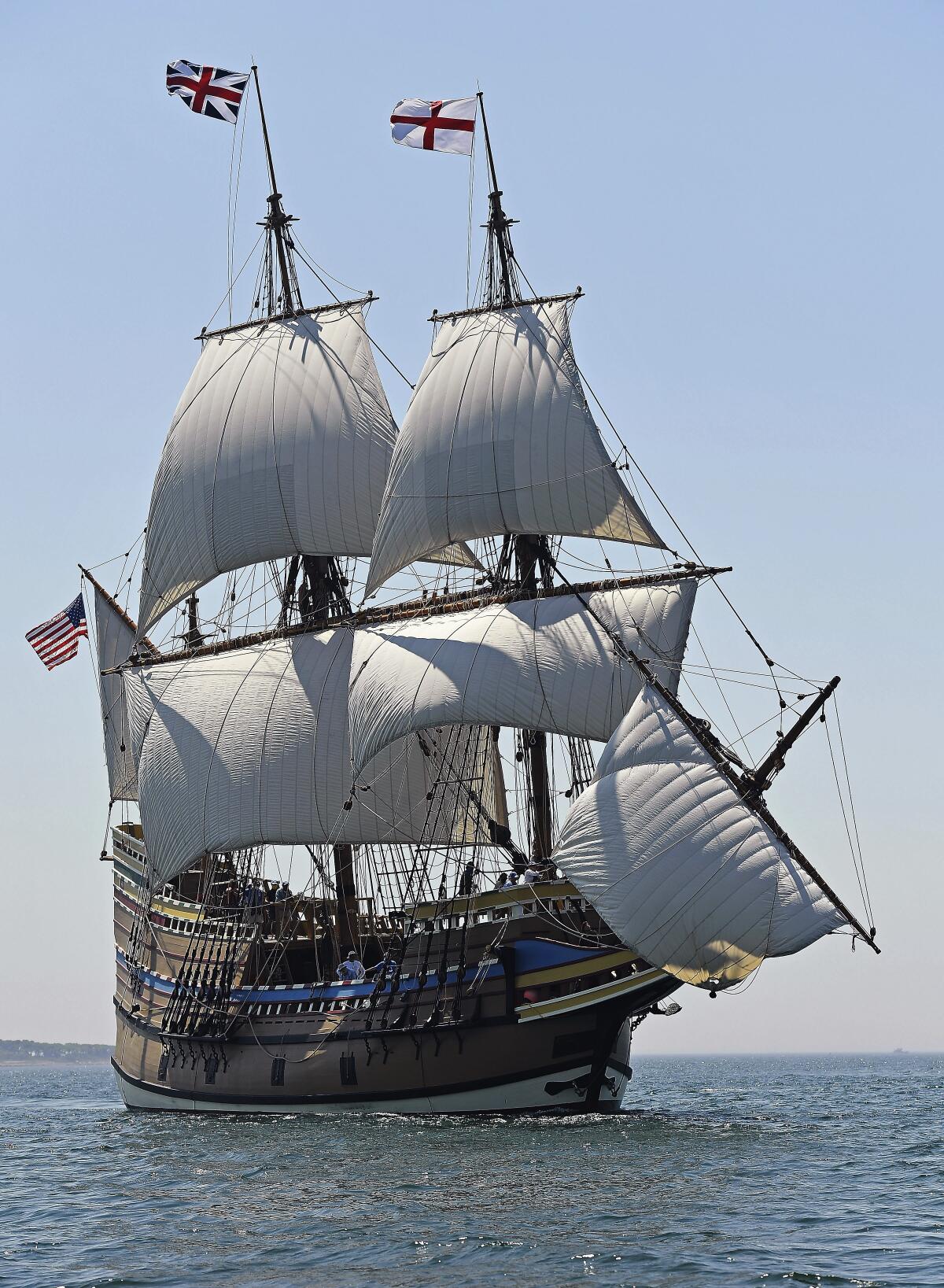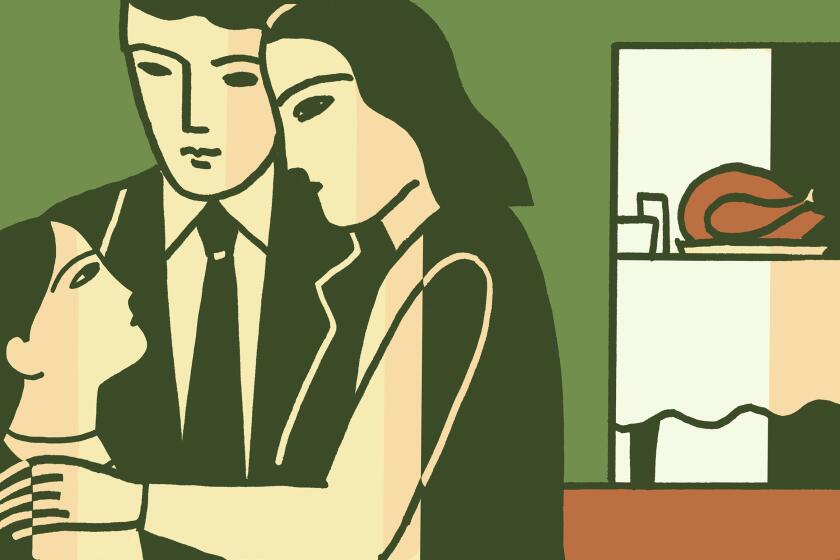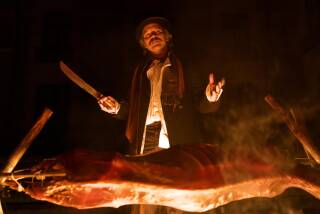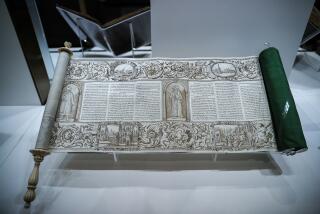Op-Ed: Pandemic tells the true story of the Pilgrims at Plymouth Rock

- Share via
Plymouth, Mass., had planned for a big party this year to mark its 400th anniversary. The replica Mayflower II, a gift to the U.S. from Britain in 1957 and now grandly restored for more than $11 million, was readied to sail ceremoniously into the harbor as tens of thousands cheered.
The last big anniversary of Plymouth’s founding, the 300th in 1920, was a huge event that held the nation’s attention. Nearly 1,400 citizen-actors took part in a historical pageant with a finale by Robert Frost. Even Plymouth Rock had a speaking role. Vice President-elect Calvin Coolidge delivered an address declaring that “Plymouth Rock does not mark a beginning or an end. It marks a revelation … shining through eternity.” The Pilgrims were the pride of America.
The pandemic has interfered with the 400th anniversary, and that disruption actually tells the true story of Plymouth. On Dec. 20, 1620, the Pilgrims came ashore where they did because an epidemic had cleared the way. Plymouth is founded on an epidemic.
The Pilgrims, as we call these religious separatists, dissenters from the Church of England, had a rough crossing. Landing first on Cape Cod, they stole the Wampanoags’ stored corn, entered their houses, taking the “best things,” and robbed a few graves, taking “sundry of the prettiest things away with us.” They wrote all this down. But they were still unsure where to settle.
They chose Patuxet, a Wampanoag village they named Plymouth, knowing it was not occupied, though they would soon see that the Wampanoags still returned there to fish. The fields — “much corn ground” — were long cleared, as if for the taking.
The Pilgrims, and the Puritans 10 years after them, had not come to a “waste and howling wilderness,” as one Puritan minister wrote in a 1651 poem. Over thousands of years, the Wampanoag people had cultivated a prosperous and bountiful land. Thriving villages were connected by a network of trails that ran through the forest and fields. Along the trails, they had dug small holes about a foot deep that were story-markers, reminders of the stories to be told at that spot. They grew corn, beans, squash and melons, hunted deer and other animals, gathered acorns, berries and roots, and fished by building weirs in the rivers and along the seacoast, where they also harvested crabs, oysters, scallops and clams.
If the Pilgrims and the Wampanoag knew that their historic feast meant more of them might die, they would have had the sense to cancel the multihousehold meal gathering — which is what we should do in honor of them and the holiday they founded.
With the many “gardens and corn fields ... the greatness of the timber growing on them, the greatness of the fish … this is a most excellent place, both for health and fertility,” wrote the English explorer John Smith in 1616, advertising the region to prospective investors and settlers.
But at the time the Pilgrims landed, the Wampanoags and their neighbors had been tested by the years they called the Great Dying. An epidemic from 1616 to 1619 — which may have been smallpox (there are other theories) — had killed as many as 9 out of 10 coastal Indians.
“A whole village might have two survivors, and those two survivors were not just like any two people,” says historian Jill Lepore. “They were two people who had seen everyone they know die miserable, wretched, painful — excruciatingly painful — deaths.” The Pilgrims found fields of bones lying above ground.
“There hath, by God’s visitation, reigned a wonderful plague, the utter destruction, devastation, and depopulation of that whole territory, so as there is not left any that do claim or challenge any kind of interest therein,” wrote King James I, granting the New England Charter and dismissing the thousands of Native Americans who remained. God had cleared the way for the English. Vacant land could be seized — vacuum domicilium in English law.
The Wampanoags, much depleted, were exposed to attack from their rivals to the south, the Narragansetts, who had been spared the epidemic. They were looking for allies. The sachem the English called Massasoit decided to reach out to the Pilgrims. (His name was Ousamequin. “Massasoit” is an honorific meaning roughly the “highest chief who speaks on behalf,” or Great Sachem.) He set in motion an alliance that would ensure the Pilgrims’ survival.
The 400 years that have followed are summed up by Linda Coombs, a Wampanoag who for years was the associate director of the Wampanoag Indigenous Program at the living history museum then called Plimoth Plantation and now Plimouth Patuxet. Visitors to the re-created village would often ask her, “Weren’t you glad when the Pilgrims came?” Answer: “No.”
“We had lived for 10[,000] or 12,000 years, by the archeological record, with the world as our creator had made it,” says Coombs. “And then in less than 400 years we’re at the brink of destruction with our ‘advanced’ technological and industrial society.”
The current pandemic is nowhere as virulent as the Great Dying, but it has tested us. Our plague year is also an opportunity. Let’s use our adversity to help us see, at last, one of the hidden truths of our nation’s founding: the great suffering of the Native people. Plymouth is built on an epidemic; our Thanksgiving is built on the bones of the Great Dying. The coronavirus is a fitting memorial for Plymouth’s 400th anniversary.
Howard Mansfield has written 10 books about architecture, preservation and history, including “The Habit of Turning the World Upside Down.” He lives in New Hampshire.
More to Read
A cure for the common opinion
Get thought-provoking perspectives with our weekly newsletter.
You may occasionally receive promotional content from the Los Angeles Times.











